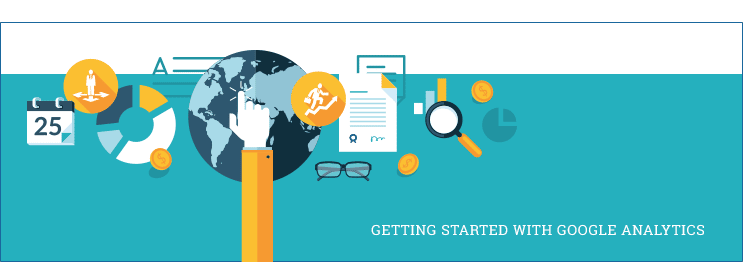Getting Started with Google Analytics
Google Analytics is a powerful tool. Do you know how to use it?
No really. Do you?
Although it’s often said that Google Analytics (GA) is one of the most useful free tools available to web masters, it’s easy to get lost in the data when you’re not quite sure what you’re looking for.
So what are we looking for?
Well, asking yourself the right questions includes knowing where to look for the right answer.
There are far too many marketers around who keep telling themselves that the more content they produce, the faster they’ll be noticed. However, what if that was completely backwards? What if you could create great content, more often?
Using Google Analytics can help you do just that. By asking the right questions, you can navigate through each report to find what you need to help you target the correct topics, audiences and keywords.
Here are some tips to get you started, in order of least difficult to masterful. Before we begin however, here are some guidelines that you should keep in mind:
– If you want to compare more than one piece of content, make sure you use the correct periods for each piece in order to get the most useful information from the data.
– Great content can be shared repeatedly the longer it’s online. Based on the questions you’re asking, try to use as long of a date range as possible to get a better picture for your answer.
– If you have any trouble looking for these reports, you can find them by using the ‘All Pages’ report. This report is located under the Behavior and Site Content link. You can adjust it by changing the primary and secondary dimensions.
Individual Reports
Reviewing Page Views
Questions Answered: General Popularity of Individual Posts, Landing Page Potential, Supplemental Page Views
To get even more out of your page view report, consider selecting a few content group headings that you can use, based on their subject matter. If you want to learn more about content grouping and how to use them for your benefit, read about them here: Content Groupings
Page Views: By Source
Questions Answered: Best Marketing Medium, Social Vs. Organic, Improving Existing Posts
Now is the time to focus on asking better questions. All you need to do is find the ‘tabular data’ that you want to view, so you don’t mix it up with your homepage or other pages that contain your content. Then, select Medium as the secondary dimension.
Depending on how your website is arranged, you might need to enter terms with more detail on your filter by choosing to use advanced options. The output you will see by using the above steps will appears as a list of URL’s, with the medium in the second column. You can see these changes all at once or you can search for individual pieces and check on performance from item to item.
By using the unique page view filter, bounce rates, page values etc.; you can get an idea of what pieces are doing well for you.
Page Views: By Title
Questions Answered: How Many Clicks Per Title, Types of Posts Performing Well, What Titles Are ‘Clickbait’
In order to figure out how your title’s are affecting your traffic, you can select Page Title as the primary dimension when you begin to review your data.
Referral Visits
Questions Answered: How Many Sites Visit You, How Many BackLinks Do You Have
Of course, traffic from your own methods is a great way to start, but at some point, you have to figure out how many of your visits are from other sites? How many of them are from your potential competitors? The thing is that you want other sites to be viewing your page. If they’re looking often, then they have something to worry about, not you.
You can also use the referral visit report to discover which types of content were most attractive to the other visiting sites, so that you can replicate the content strategy in the future for SEO.
While it can be tricky to navigate, the best way to view your referral visit information is by going to the Acquisition>All Referrals report, and then, set your primary dimension to the Landing Page.
Now, you can go even further and use the table filter to exclude any pages that are not content piece pages.
Social Referrals
Questions Answered: Types of Content Shared, Content Popularity Per Platform, Most Popular Day of the Week
By using this area of your report, you can discover what types of content is shared across multiple types of platforms. Linked in and Twitter are much different from Facebook or Google+, therefore, you need to know what works best in each of these scenarios.
Go to the Acquisition>Social Reports. More directly, view your Network Referrals and Landing Page reports. Each one can show you how to tailor your approach. You can choose your own primary and secondary dimensions to segment the data for further research.
Weighted Sort
Although this report, really isn’t one, it can still provide you with a wealth of useful information. At its finest, it takes all of the nonsensical data about your site, and it turns it into information that can be useful to you.
As an example, you could use your bounce rate at you initial search and then follow that with a weighted sort. The weighted sort will help you view your bounce rate in a way that will make it easy to see how each piece of content was able to keep someone on a certain page, while others will show you what it was the drove people away. There are more data points than you can use with the weighted sort, but you can’t do everything with it.
Demographic Reports
Questions Answered: Whom Am I Marketing To, Who Should I Market To Next, Who Is Reacting Positively To Me
If you’re interested in doing marketing, retargeting and demographic research, this tab has all the information you’ll need. Go to Audience>Demographics and Interests Reports. This can help you update your marketing efforts and get more out of your target audience.
Page Value
While this page doesn’t really count as a report, the data contained in it is very much underutilized. Page Value can be located as the right-most column in the data on the Site Content report. If you want to review this information, you need to make sure you set up goals first. This includes a goal value. If you haven’t set up values, yet you can see how goal values are created with this link: How To Create Goal Values. Remember that the values don’t have to be perfect in order to get some data that will help you understand your site better, and that is fairly easy to work with.
If you want to continue to create content that will help you create more traffic and revenue, you need to start with the pages that have a higher value, and create content similar to those.
Overall
There is more than one way to determine how your content is performing. Stopping at page views is a poor way to research your ability to expand your presence and is a short sight for one who has business goals that other companies will one day attempt to emulate. Once you learn the right questions to ask, you can use the data at your fingertips to evaluate the efforts you have already made. In order to improve and advance your position at marketing with content, you should try to use these tips and increase your understanding of the information pulled directly from your pages.
How do you use GA to master your content? Leave your tips in the comments below!



